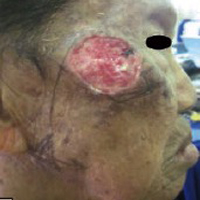Successful basal cell carcinoma defect reconstruction using combination of rotation and advancement flap: Two case reports

Accepted: 20 April 2021
HTML: 117
All claims expressed in this article are solely those of the authors and do not necessarily represent those of their affiliated organizations, or those of the publisher, the editors and the reviewers. Any product that may be evaluated in this article or claim that may be made by its manufacturer is not guaranteed or endorsed by the publisher.
Defects resulting from surgical procedure may be challenging to reconstruct depending on the size and location. In case of large defects, primary closure is often not possible and thus requires skin flap or graft. In such cases, skin flap is advantageous as it produces a similar color and texture with the surrounding tissue. Skin flap techniques such as advancement flap, rotation flap dan transposition flap are useful in closing small defects. In moderate to large-sized defects, especially in areas with high tension, a combination of more than one type of flap might be necessary. This report describes two cases of large defects on the temple and cheek following basal cell carcinoma excisional surgery which were successfully closed using a combination of rotation and advancement flaps. Both patients showed excellent functional and cosmetic outcome.
PAGEPress has chosen to apply the Creative Commons Attribution NonCommercial 4.0 International License (CC BY-NC 4.0) to all manuscripts to be published.





 https://doi.org/10.4081/dr.2021.9087
https://doi.org/10.4081/dr.2021.9087



